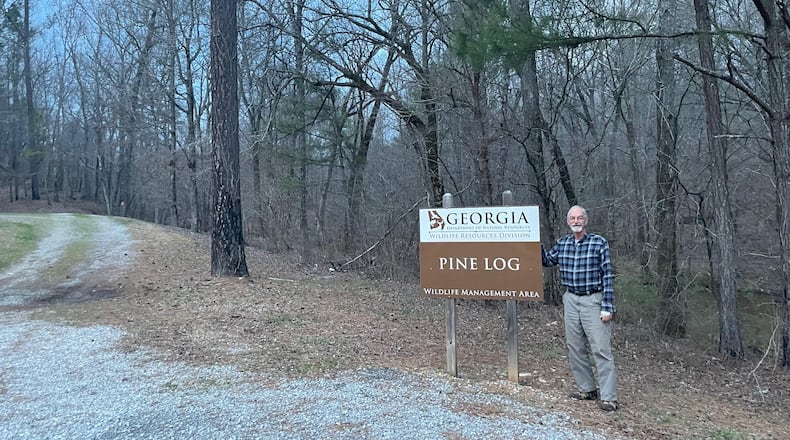The Pine Log Wildlife Management area north of Cartersville is a massive tract of rolling, forested land the size of Manhattan.
For more than 40 years, the state has leased the 14,134-acre expanse from the family that has owned it for nearly a century. The land is a Georgia history lesson, with long-abandoned mining towns and convict labor camp, timber tracts, mountains and, of course, sites where Native Americans lived long ago before they were driven away.
If there was ever a haunted and majestic area, this is it.
Now that land — and another 5,000 acres adjoining it — is up for sale and there’s consternation that bulldozers will have their way with it.
The state is apparently interested in buying most of it. All it will take is several hundred million dollars.
Georgia had a $6 billion-plus surplus this year and you might think it’s itching a hole in someone’s pockets. And, as they say, they aren’t making any more land. So, let the negotiations begin.
Bob Neel is the steward of the family that owns the land right off I-75 and running north along U.S. 411, an increasingly popular thoroughfare for industry and warehouses.
Neel, a tall, lanky bearded fellow, has farmed portions of it for decades and loves to meander the thousands of acres the family started amassing in the early 1930s.
“We’d be thrilled if the state bought it,” Neel said while taking me on a driving tour of the property with his wife, Janet. “The state has indicated they’d like additional acres — 16,500. The state’s appetite is pretty large.”
I‘ve heard the figure of $300 million-plus mentioned more than once, although the real estate agent figures he could get $1 billion over the next 10 years if he carved it up into chunks and sold it to the various interested parties — the mining interests, the manufacturers, the distribution folks, the retailers, and, of course, homebuilders.
Credit: Bill Torpy/AJC
Credit: Bill Torpy/AJC
“We know what it’s worth,” Neel told me, adding he’d prefer the state buy it and keep most of the acreage as it is. However, he said he’d probably “peel off some of the more valuable parcels” and sell them for what they are worth. Real estate broker Jim Ramseur figures there are tracts worth $100,000-plus an acre. Start multiplying that price with hundreds and hundreds of acres and you’re talking real money.
When asked why he’s selling, Neel said simply, “It’s time.”
His home sits on the south end of the property near I-75 and U.S 411 on land that’s now insanely valuable. Even though the family owns 19,000 acres with some secluded mountain slopes and quiet hollows, the Neels’ home is near a concrete plant that continually shakes his walls.
But it’s more than that. Impatient motorists make it dangerous to traverse nearby roads with his slow-moving farm equipment. Most importantly, there are now 32 family shareholders who make up the family corporation. Some of them, especially the younger ones who have scattered across the country, would like to get their portion of what that land is worth. Getting that number of shareholders to support something is difficult. But wait another generation and it’ll be twice that many family members and totally unwieldy.
Bartow County resident Reece Monroe started a petition urging the state to buy as much of Pine Log as it can. On Tuesday, his friend, Lisa Lipscomb, brought printed versions of the 11,500 signatures to the governor’s office, the Department of Natural Resources and the office of economic development.
“Pretty soon, the scales are going to tip one way or another,” Monroe said, meaning a decision between preservation or the chop-it-up and sell-it-off will happen. But that’s just talk on the street. No one really knows. Or at least those who know aren’t saying.
“We have this jewel of wilderness that we don’t need to go away,” Lipscomb told me.
Credit: Bill Torpy
Credit: Bill Torpy
Mike Worley, president of Georgia Wildlife Federation, echoed that: “Because of its location and diversity of location, Pine Log is extremely important. You don’t often see a tract like that, especially not near Atlanta.”
State officials are largely mum, other than to say they’re working on it. I don’t imagine they’d say much. If you’re buying a house, you don’t tell the seller there’s a nice view from the porch. You say the floor is rotting and hope they’ll knock off a few bucks.
After traversing a dirt road to visit a lake framed by mountains, Neel took me to Stamp Creek, a shallow stream with water clear enough for trout. As the sun set, a man with a fishing vest and a pole walked by. We talked and he spoke about the land as it it was magical.
“I don’t want to see it go; there’s no place on the state’s north end like this,” said Stacey Smith, a Cherokee County resident. “It’s some of the most beautiful land that I know.”
He mentioned the family landowners a couple of times, not knowing he was face-to-face with the Neel family company’s CEO.
Smith said he comes to the land with his 4-year-old grandson. “I hope it’s there for him in the future,” he said.
Walking away, Neel laughed, telling me, “I swear I didn’t plant him.”
The fisherman’s sentiment is a common theme around there.
About the Author
Keep Reading
The Latest
Featured




